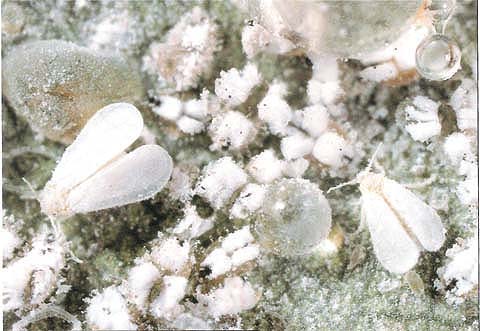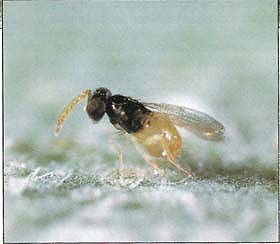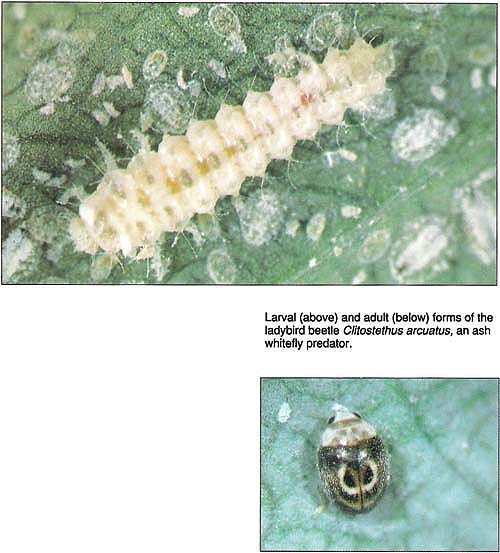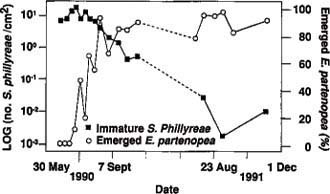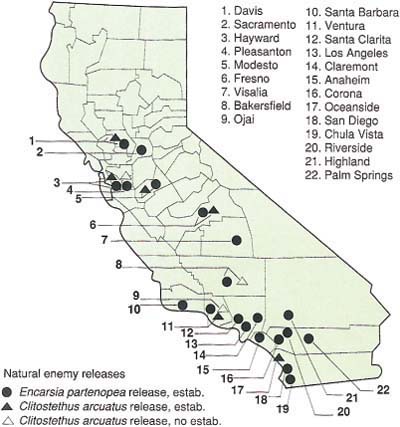All Issues
Biological control of ash whitefly: a success in progress
Publication Information
California Agriculture 46(1):24-28.
Published January 01, 1992
PDF | Citation | Permissions
Abstract
Two natural enemies of ash whitefly (Siphoninus phillyreae), jntroduced into California in 1990, proved effective in Southern California field trials, completely controlling this Dest in release sites within -24 months, Evaluations in release sites in Central and Northern California, Arizona and Nevada look equally promising.
Full text
Above, dense populations of winged adults (each about the thickness of a penny, or 1.5 mm) and nymphal stages of ash whitefly cover foliage, producing large amounts of honeydew (the clear droplet). Whiteflies feed on ash and other ornamentals, and a variety of fruit trees.
Exotic whiteflies have long threatened California's farms and gardens. At least eight species are established in the state; several more recognized pest species exist in other Western Hemisphere areas and in regions bordering the Pacific Basin.
Damage to plants is typically related to large populations feeding on leaves and to production of large quantities of honey-dew. Because whiteflies typically do not infest fruits, the presence of a particular species in an agricultural region does not usually precipitate the quarantine and shipping restrictions associated with such insect pests as Mediterranean fruit fly. Furthermore, tools typically employed for early detection of low insect population densities, such as pheromone or bait traps, are not available for whiteflies, and newly introduced whiteflies are often widespread before they are discovered. Consequently, modern strategies for managing populations of exotic whitefly pests typically center around biological control rather than eradication.
The history of Siphoninus phillyreae (Haliday) in North America typifies many introduced whiteflies. Siphoninus phillyreae is an Old World species, reported in the Eastern Hemisphere from Morocco to India, and from Ireland to Central Africa. Its discovery in California was the first recorded in the Western Hemisphere. In the absence of effective natural enemies in California, this whitefly subsequently developed extensive, damaging populations.
Siphoninus phillyreae whitefly develops continuously, although more slowly during cooler (winter) temperatures, completing several generations each year. In heavily infested areas populations rapidly occupy undersides of all leaves on susceptible trees. Nymphal populations on trees cause premature dehiscence of leaves and defoliation, severely reduce yield in fruit trees and, in some cases, cause the death of young pear trees following repeated defoliation. Honeydew produced by whiteflies falls on sidewalks, lawns and automobiles, and is carried by air currents and foot traffic into homes, causing sticky furniture, draperies and carpets. It further serves as a medium for sooty molds, which discolor any surface affected by the honeydew, including fruit intended for market. Adult populations reach astounding levels, limiting outdoor activity in many areas. Principally affected are ornamental shade trees as well as pomegranate, apple, pear, citrus and, to a lesser degree, stone fruits. Infestations affect not only agricultural production but also dramatically affect the quality of life in urban communities.
The biological control program employed exemplifies the approaches suitable for limiting the impact of many pests introduced in urban and agricultural settings. These approaches include (1) detection of the pest and mounting of a biological control program, (2) foreign exploration and introduction of exotic natural enemies, (3) evaluation of natural enemy potential and (4) regionwide distribution of natural enemies.
The problem
Siphoninus phillyreae was first identified in California in Los Angeles in August 1988. The infestation was widespread in Los Angeles, Orange and San Bernardino counties, and high densities in some areas indicated that the infestation had existed for one or two seasons before 1988. The infestation spread rapidly, and now this whitefly is found in nearly every county in California; infestations are also reported in Nevada, Arizona and New Mexico. Following meetings with agricultural commissioners and state agricultural officials in January and February 1990, initial funding for establishing a biological control program at the University of California was secured from UC funds, agricultural commodity boards, county boards of supervisors, and the California Department of Food and Agriculture (CDFA).
Natural enemies found, introduced
During 1989 and 1990, T. Bellows, (UC Riverside), L. Bezark (CDFA) and D. Gerling (University of Tel Aviv) introduced nine populations of natural enemies into UC Riverside quarantine facilities. Three populations reproduced in quarantine: the tiny parasitic wasp Encarsia partenopea from Italy, E. partenopea from Israel, and the predaceous ladybird beetle Clitostethus arcuatus from Israel. Initial shipments were received in late summer 1989 and, following clearance through quarantine protocols, the first releases of wasps from Israel were made in October 1989; first recoveries were made approximately 6 weeks later. The beetle was released first in spring 1990 in coastal San Diego County where it, too, became established. Early results from the wasp releases were encouraging, and during the winter, colonies of the wasp from Israel were, developed and expanded.
Initial research: parasitic wasp
Experiments were conducted in Riverside in summer 1990 to assess the effect of E. partenopea on populations of S. phillyreae. At sites where parasites were released in May, densities of the whitefly remained below 8 immature insects/cm2 (52/in2). In contrast, whiteflies were increasing in density during early summer at nonrelease sites. Nonrelease sites did not remain free of parasites for long, however, even though they were up to 11 km (7 miles) from release sites. Once the parasite entered a population, the percentage of whitefly nymphs producing E. partenopea, rather than adult whiteflies, rapidly increased (fig. 1). As a result of decreased production of adult whiteflies, densities of S. phillyreae, which had been increasing in the absence of E. partenopea, began to decline. By October 1990, the density of S. phillyreae had been reduced 13-fold. Densities of S. phillyreae continued to drop in 1991, and by September 1991, whitefly densities were between 3 and 4 orders of magnitude or 1,000 to 10,000 times lower than they had been at the peak in 1990 (fig. 1). Emergence of E. partenopea continued to constitute 80 to 98% of the total emergence of whiteflies and parasites from S. phillyreae nymphs. Densities of S. phillyreae were so low in 1991 that the whitefly is now difficult to find in Riverside and in most other parts of Southern California. The wasp was distributed in summer 1990 in several locations in Los Angeles, San Bernardino, Riverside, Orange and San Diego counties, and results in these locations were similar to those obtained in Riverside.
Larval (above) and adult (below) forms of the ladybird beetle Clitostethus arcuatus, an ash whitefly predator.
Regionwide evaluation
The wasp E. partenopea and the beetle C. arcuatus from Israel were distributed in several whitefly-infested areas in 1990 to evaluate the overwintering ability and subsequent level of biological control achieved by these natural enemies in climatic regions throughout infested portions of the state. Releases were made in Alameda, Fresno, Kern, Los Angeles, Sacramento, Santa Barbara, Stanislaus, Tulare, Ventura and Yolo counties during September and October 1990; subsequent releases were made beginning in June 1991. The parasite became established in all counties (fig. 2), but establishment of the beetle was less uniform. Populations became established following releases in Hayward (on San Francisco Bay), Modesto, Fresno, Davis and Ventura, but not in Pleasanton, Bakersfield or Ojai. More research will reveal whether the beetle will eventually establish in these locations.
Fig. 1. Changes in density of immature ash whitefly (Siphoninus phillyreae) and percentage of whitefly pupae producing parasitic wasps (Encarsia partenopea) rather than adult whiteflies on pomegranate in Riverside, 1990-1991.
During 1991, a few city governments contracted UC to distribute and evaluate the natural enemies in their areas, and this work was conducted in cooperation with local Cooperative Extension personnel. In addition, during 5 weeks in summer 1991, more than 100,000 wasps were distributed to public agencies and private individuals, primarily in Southern California and, in smaller numbers, to locations as far north as Yolo County.
Releases of E. partenopea had substantial impacts on the populations of S. phillyreae by the end of summer 1991 in all locations. For example, by October virtually all of the whitefly fourth instar nymphal exuviae examined in Santa Barbara had evidence of emergence of parasites rather than adult whiteflies. There was little defoliation of trees in Modesto at the initial parasite release sites and surrounding neighborhoods, although defoliation did occur at sites where the parasite appeared much later in the season. Parasitism rates were substantial in every release site examined throughout California.
Fig. 2. Release locations of the parasitic wasp Encarsia partenopea and the predaceous beetle Clitostethus arcuatus. Each point indicates one or more release locations at each study site. The hollow triangles in Kern, Ventura and Alameda counties indicate locations where no establishment was apparent after single releases of the beetle.
The number of parasites released in a particular location affected the rate of population growth and spread. The cities of Modesto and Fresno present two different philosophies and patterns of establishment. Both cities received the same initial number of parasites (750) as part of the UC project (plus an additional 250 individuals as part of the CDFA distribution to counties statewide). In addition, the Parks and Recreation Department of Modesto acquired 5,000 parasites in May and another 5,000 in July 1991 from UC. These wasps were initially released at parasite nursery sites. Their progeny were collected and uniformly redistributed on a quarter-mile grid throughout the city. In Fresno, individual citizens acquired 3,000 E. partenopea in July for release on private landscapes. Adult parasites were first detected in samples taken in Modesto on June 18, but not until August 22 in Fresno. For further comparison, 46 parasites were counted in a 5-minute visual-sampling period on the underside of host tree leaves on August 27 in Fresno, and lower leaf surfaces were 70% covered by all whitefly stages. However, on August 2, an average of 408 parasites were counted in a similar sampling period on leaves in Modesto. Only 40% of the leaves contained whitefly life stages. The adult population of parasites was 10-fold larger and the level of damage was almost 60% lower in Modesto, which initially released a larger number of natural enemies, began releases at an earlier date and subsequently redistributed the parasites.
The wasp has now been distributed, through both UC programs and state programs, in varying numbers throughout infested regions of California, and through UC programs also to Arizona and Nevada. It appears to function well in all the climate zones into which it has been introduced, including the deserts of California and Arizona, Calif ornian coastal climates, and interior valleys, from Mexico to northern Central California. This parasite will likely play a major role in limiting S. phillyreae populations in all of these areas.
Outlook
The biological control program against S. phillyreae exemplifies several characteristics vital to modern, effective use of biological control as a management tool against invading, exotic pest species. It is perhaps one of the most visible examples of biological control in an urban setting and exemplifies the potential significance of this approach to managing pests in urban landscapes.
Significant in the program's development was early participation by several funding agencies, which included not only commodity groups concerned about the impact to agriculture, but also several civic governmental organizations, particularly county agricultural commissioner's offices and county boards of supervisors. Support from local governmental organizations may play a critical role in developing future biological programs affecting urban environments. Many pests of urban and periurban settings, such as those of ornamental landscapes, may not precipitate concerns or support for research from agricultural industries, but are eminently suitable candidates for biological control. The success of, and rate of implementation of, biological control in urban environments will depend partly on continued involvement by local and state governments in representing the pest control interests of urban residents.
Additionally, among the important characteristics of this program were the facilities of UC Riverside with its capabilities in biological control. Biological control has occupied a central place in California pest management strategies for decades, and this heritage has been the result of careful program development and a commitment by UC and state and federal resources to maintain the personnel and facilities necessary to conduct such programs. Facilities such as the quarantine laboratory and the Department of Entomology at UC Riverside are critical to maintaining biological control programs.
Furthermore, there were substantial commitment and assistance from colleagues in California and overseas to develop the program. This assistance was the result, over many years, of networking by researchers addressing similar problems in similar ways, and represents a vital, and often unappreciated, dividend from the maintenance of academic and research institutions. These factors allow UC to respond rapidly, and often successfully, to new invasions.
Exotic whiteflies have persisted in California, but biological control has helped manage four of the eight species present. Other whitefly species that threaten both urban and agricultural communities, but are not now in California, are the orange spiny whitefly, currently in Southeast Asia; the spiralling whitefly, currently in Florida, the Caribbean and Hawaii; and the citrus blackfly, currently in Horida, Texas, the Caribbean and Mexico. Other exotic whiteflies present in California are being evaluated for their impact and candidacy for biological control. (The outlook for one of these, the sweetpotato whitefly, is described in the accompanying sidebar.)



